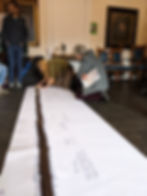Deep Peat - Into the Depths of Time
- Carys Mainprize
- Oct 21, 2022
- 4 min read
Crichton Carbon Centre’s Peatland Connections project was delighted to take part in the Scottish Archaeology Fair hosted in Castle Douglas by Archaeology Scotland and Galloway Glens the 4th September this year. For the fair we showcased an amazing peat core timeline and asked members of the public to add their own dates. In this blog Peatland Project Officer Jack travels back in time to the fair and beyond, delving deep into a wealth of climate and human history.
Most of the stories that a peatland can tell lie deep below the surface. Peat forms at approximately 1mm per year in layers in a process known as stratification, as partially decomposed organic matter such as Sphagnum and Cottongrass accumulate in the anaerobic conditions. Over millennia peatlands can become metres deep, some exceeding 10 metres. Scientists can take peat cores and study features such as pollen to read into the historic climate and environment.

At the Carbon Centre our journey down below began before the Archaeology Fair when the team headed to an area of afforested peatland near Clatteringshaws Loch in Galloway. The plan was to collect a peat core for the fair using a strong and heavy Russian Corer. Collecting the core was very hard, physical labour taking many hours of pushing and heaving to extract the samples. By four metres down the going was getting extremely tough and penetrating the peat was becoming nearly impossible due to the increasing presence of woody materials. In total Lewis and Anna managed to extract 4.6 metres of peat.

At the Archaeology Fair we laid out the peat core on a long roll of white paper. The room was only just large enough to accommodate us. Peat is an extremely waterlogged organic material and throughout the day the peat core oozed onto the paper, leaving a peaty impression of where it sat. Many people were fascinated by the squidgy but firm properties of the peat and taking a closer look with a magnifying glass identified fragments of plants that grew thousands of years ago.

We started adding dates to our timeline. Assuming the peat formed at an average of 1mm per year the peat core took us back approximately 4,600 years to the end of the Neolithic. The changing climate in the Neolithic gave way to wetter, windier and colder conditions and is thought to have played an important role behind agricultural expansion. Humans moved away from hunter-gathering and transitioned to farming, although this would have happened more slowly in upland areas where communities were dispersed.
Gradually we moved along timeline, charting the disappearance of Scotland’s native forests and Elk in the Bronze age and the start of the Iron Age around 2,800 years ago. Lochs and bogs appear to have been of religious or ritual significance during the iron age. During the Iron Age peatlands were prime locations for the discovery of Bog Iron. This impure iron deposit can be extracted and worked to yield valuable metal products so was important during this period.
Analysis of natural climate records such as ice cores, dendrochronology (tree rings) and peat cores demonstrate that the climate has continually changed throughout history. For example, Europe is thought to have endured ‘The Little Ice Age’ between 1300-1850 CE where temperatures dropped 0.6C below average in the Northern Hemisphere, some years dropping 1-2C below average.

Throughout the day our timeline filled up with dates, and members of the public had the opportunity to add their own events of interest using miniate flags to mark the occasions. Some local dates added to the timeline included when Robert the Bruce Fought at Moss Raplochin 1307; when bogland was drained and revealed the Torrs Pony Cap in 1812; and when the Galloway Forest Park was established in 1947. Of course, many of the dates we are familiar with are focused within the last couple of centuries, so the top few-dozen centimetres of the core became rather congested! This perspective made the period that we, as individuals, spend on planet earth seem trivial: less than 10cm of peat for the average human lifespan.
However, it also reminded us that the impact we have on the planet is sobering. In 2017 the Intergovernmental Panel on Climate Change reported that human-induced warming reached approximately 1C above pre-industrial levels. 2020 marked the end of earths warmest 10-year period on record. In 2022, the UK was heat record was broken at Coningsby (Lincolnshire) on 19th July 2022, where temperatures exceeded 40C. If we continue on our current trajectory with existing policies, the planet is set to reach about 2.7C of warming by the end of the Century. This trajectory could go either way. The IPCC has set out several climate scenarios highlighting that just how different our world looks in the future is up to us.
There is no changing what has happened in the past. We can only wonder, marvel or despair at what has come before. But as we now look towards the future, peatlands play a crucial role in helping us on a brighter path. The peat core is a small reminder of the millions of tonnes of carbon that peatlands store and therefore the importance of valuing and protecting our peatlands for the future.
